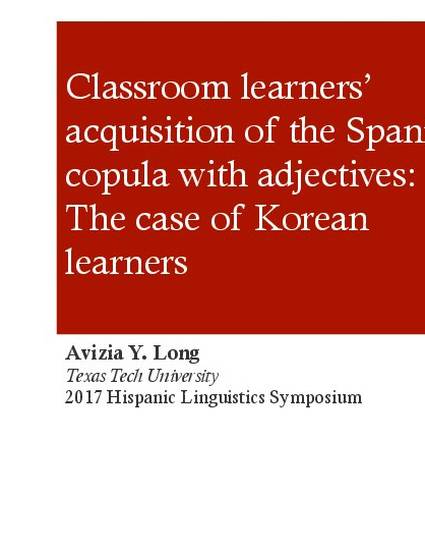
Presentation
Classroom learners’ acquisition of the Spanish copula with adjectives: The case of Korean learners
Hispanic Linguistics Symposium
(2017)
Abstract
Research on the second language (L2) acquisition of the Spanish copula with adjectives (e.g., Ella es/está bonita “She is pretty”) has been central to our understanding of learners’ development of sociolinguistic competence, or the ability to use a L2 in linguistically- and socially-appropriate ways (Canale & Swain, 1980). However, this research has been conducted nearly exclusively on native English-speaking learners (Geeslin, 2011), limiting the generalizability of attested findings to learners of distinct first language (L1) backgrounds. This study examined 66 native Korean-speaking learners’ acquisition of the Spanish copula with adjectives. Specifically, the range and frequency of copula forms produced in [copula + adjective] (i.e., attributive) contexts were explored across distinct proficiency levels, as well as the linguistic and extralinguistic variables predicting copula use.
The Korean learners were enrolled in university-level Spanish language and/or content courses in South Korea at the time of the study. Learners were assigned to one of four levels as determined by their performance on an independent, grammar-based proficiency assessment. To examine learners’ use of the copula in attributive contexts, each learner participated in a sociolinguistic interview and picture book description task from which all [copula + adjective] contexts were identified and coded for seven independent linguistic variables (following previous research on English-speaking learners, e.g., Geeslin, 2000, 2003) and three independent extralinguistic variables (speaker gender, task type, and Spanish language proficiency).
Results demonstrated that the three most frequent copula forms produced with adjectives by Korean learners at each level of proficiency included ser, estar, and nonnativelike omission. However, as proficiency increased, the use of ser and estar also increased. The independent variables found to significantly predict the choice of estar over ser included predicate type, whether the adjective was a resultant state (e.g. casado “married”), and Spanish language proficiency. Findings are compared to patterns of use observed for native speakers to highlight targetlike trends, as well as patterns of development observed for English-speaking learners to facilitate the discussion of shared characteristics of acquiring the copula with adjectives.
Disciplines
Publication Date
October 27, 2017
Location
Lubbock, TX
Citation Information
Avizia Y. Long. "Classroom learners’ acquisition of the Spanish copula with adjectives: The case of Korean learners" Hispanic Linguistics Symposium (2017) Available at: http://works.bepress.com/avizia-long/36/
